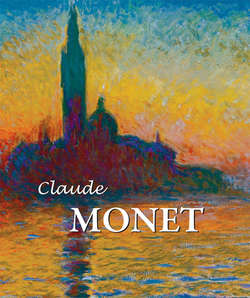Claude Monet

Реклама. ООО «ЛитРес», ИНН: 7719571260.
Оглавление
Nina Kalitina. Claude Monet
The Beginnings of Impressionism
Claude Monet – The Person
Early Life
Formative Years
From Figure Painting to Landscape Painting
The First Impressionist Exhibition
The Argenteuil Period
From the Single Painting to the Series
Monet’s Reception in Russia
Exhibitions
Biography
Bibliography
Отрывок из книги
Pierre-Auguste Renoir, Claude Monet, 1875.
Oil on canvas, 85 × 60.5 cm.
.....
Rousseau began painting “what he saw before him” in Normandy, in the mountains of the Auvergne, in Saint-Cloud, Sèvres, and Meudon. His first brush with fame was the Salon of 1833, well before the birth of the future Impressionists, when his View on the Outskirts of Granville (The State Hermitage Museum, St. Petersburg) caused a sensation due to its focus on a mediocre, rustic motif. A contemporary critic wrote that this landscape “is among the most realistic and warmest in tone of anything the French School has ever produced.” (A. Sensier, op. cit., p. 38). Rousseau had discovered a sleepy little village called Barbizon at the entrance of the forest of Fontainebleau. There he was joined by his friend Jules Dupré and the aforementioned Narcisse Diaz de la Peña. Another of Rousseau’s painter friends who often worked at Barbizon was Constant Troyon. In the late 1840s, Jean-François Millet, known for his paintings of the French peasantry, moved to Barbizon with his large family. Thus was born the group of landscape painters that came to be known as the Barbizon School. However, these landscape artists only executed studies in the forest and fields, from which they subsequently composed their paintings in the studio. Charles-François Daubigny, who also sometimes worked at Barbizon, took the idea further than the others. He established himself at Auvers on the banks of the Oise and built a studio-barge he called the Bottin. Then the painter sailed the river, stopping wherever he wished to paint the motif directly before him. This working method enabled him to give up traditional composition and to base his colour on the observation of nature. Daubigny would later support the future Impressionists when he was a jury member of the Salon. But Camille Corot was perhaps the closest to the Impressionists. He was living in the village of Ville-d’Avray near Paris. With characteristic spontaneity, Corot painted the ponds near his house, the reflection in their water of weeping willows, and the shaded paths that led into the forest. Even if his landscapes evoked memories of Italy, Ville-d’Avray was recognisable. No one was more sensitive to nature than Corot. Within the range of a simple grey-green palette he produced the subtlest gradations of shadow and light. In Corot’s painting, colour played a minor role; its luminosity created a misty, atmospheric effect and a sad, lyrical mood. All these characteristics gave his landscapes the quality of visual reality and movement to which the Impressionists aspired.
The Chailly Road through the Forest of Fontainebleau, 1865.
.....